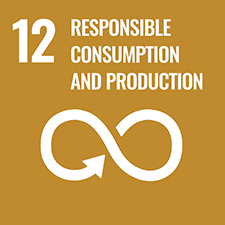![[Podcast] Sustainable Restructuring of the Southeast Economic Region (Part 1): Regional Restrictions from the Bottlenecks](/images/upload/img_background/ueh-bg-045231-041823.png)
[Podcast] Sustainable Restructuring of the Southeast Economic Region (Part 1): Regional Restrictions from the Bottlenecks
17 Apr, 2023
The Southeast region is making important contributions to the growth and the development of the whole country; on the other hand, it is facing the challenge of economic recovery and moving towards sustainable development in the long term. Regarding this problem, University of Economics Ho Chi Minh City (UEH) has been making efforts to contribute towards the development of the Region through research and consulting activities. This article analyzed the bottlenecks in the development of the Region, from which, proposing the structural policies or implemented mid- and long-term restructuring with the purpose of ensuring the sustainable development of the Region.
In compliance with Resolution 24/TW (2022): “The Southeast must be a dynamic development region, a center of economy, finance, trade and services, education and training, and development of high-quality human resources, science and technology, innovation, digital transformation leading the country and Southeast Asia, playing an important role in linking development with other economic regions”. In order to progress towards the development of the Southeast region (SE) in accordance with this goal, first, it is necessary to find out the following 2 issues: (i) which important bottlenecks for economic development that the Southeast region is facing; (ii) which consequences these bottlenecks result in if the Region does not take proactive policy actions to overcome. In the first part of the article, the analysis regarding the Regional bottlenecks is to be presented as follows.
Economic bottlenecks in the Southeast Region
The proportion of skilled workers in the Southeast region is approximately equal to that of the National average. The average proportion of trained workers in the Region tends to increase over time; however, the increase has not accelerated much in the past 10 years. The average annual increase to approximately 1%, reaching only 25% lower than those of the total workers in the Region in 2020. Except for Ho Chi Minh City and Binh Duong Province, the proportion of trained workers is much higher than those of the other localities in the Region, nearly 40% and 30% in 2020, respectively. These figures are much higher than that of the Regional average while those of the other localities are much lower than the regional average. That the rate of skilled labor is low is considered as one very crucial bottleneck in technological upgrading in the context of the Fourth Industrial Revolution. The current situation regarding the Region that favors industrial and service development while being labor-intensive has clearly demonstrated the limitations in localities with many industrial parks listed as Ho Chi Minh City, Binh Duong Province, and Dong Nai Province in the context of Covid-19 taking place in the two 2020-2021 years.
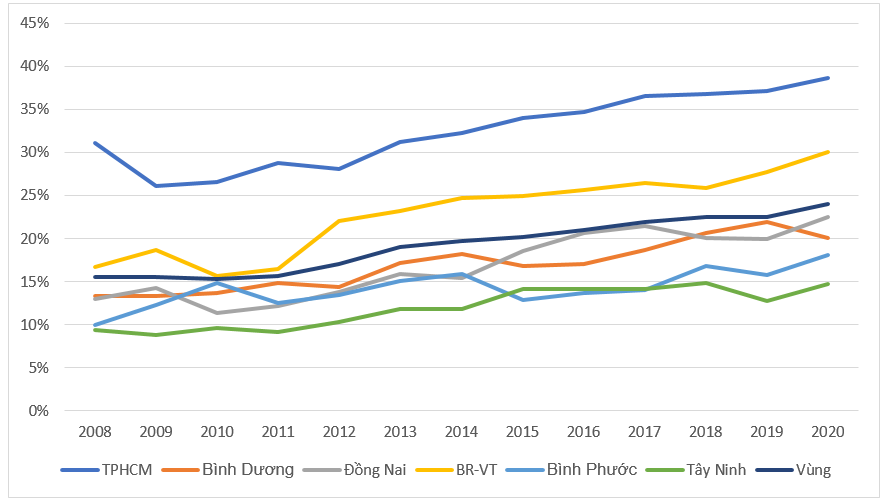
The proportion of trained workers upon the total number of employees
Source: Calculation from GSO data
The growth and the restructuring in the Region have been being capital-intensive, with low technology and governance contributions besides the tendency to decrease. In the 2013-2020 period, the Southeast region with an average growth rate of approximately 6.5% per year with more than half of capital contribution and 1/5 of labor contribution, the remaining contributed from quality growth is comprised of: Provincial/City governance in the region and technological innovation accounting for about 30%. Nevertheless, what interests is that the contribution from the quality of growth, over time, has been on a downward trend, in which, the strongest decrease is in 2020.
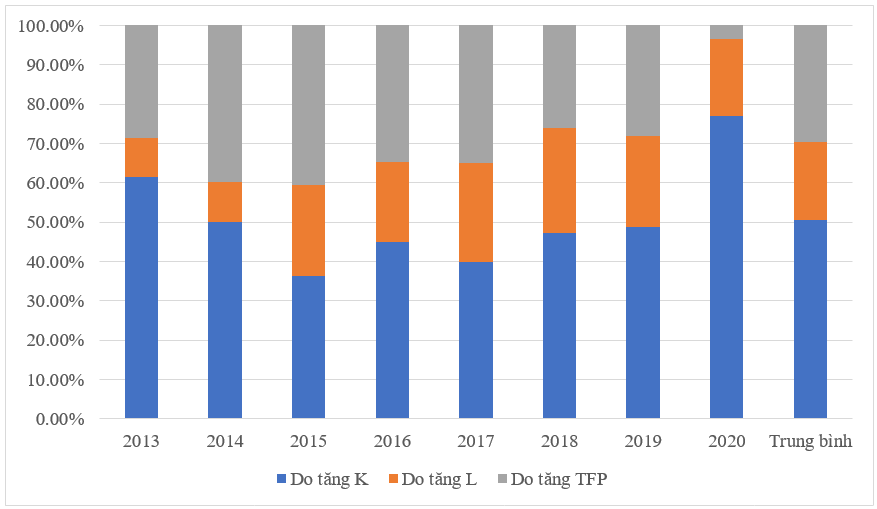
The contribution of the factors to the growth rate of GRDP Region
Source: Calculation from GSO data
The economy of the Southeast Region is presenting the signs of energy-intensive production in terms of the GRDP generation process: GRDP/power unit decreased from 20 (2010) to 17 (2021). GRDP is generated from one regional electricity unit. This downward trend over time creates one hypothesis that the efficiency of GRDP generation from electricity is decreasing over time. This indicator of the growth consequences results from labor and capital intensity besides the medium and low-level technology. The exception of Ho Chi Minh City which generates a superior GRDP/ power consumption compared to those of other localities demonstrates that HCMC’s economic structure tends to outperform other localities in the Region in terms of productivity and efficiency and HCMC has energy efficient generation twice compared to that of the average GRDP of the Region. In particular, BR-VT has the lowest GRDP/power level. That all the remaining localities have a decreasing GRDP/electricity ratio over time means that the trend in production efficiency from the input of electricity in the Region, which is on a downward trend. This fact may imply that Technology and governance levels tend to be slow at modifying over time and have not kept in pace with the green and environmentally friendly growth expectations of the Region.
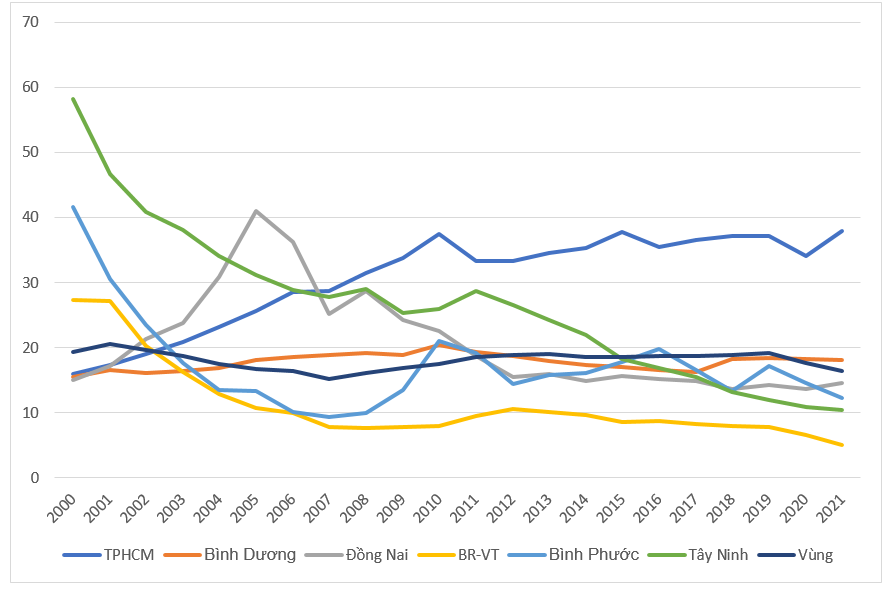
GRDP ratio to electricity consumption (billion VND/1 million Kwh)
Source: Calculation from GSO data
Local governance is at a good level whereas the Regional governance issues have not been paid adequate and effective attention. The Governance of the Southern Key Economic Zone, as assessed by the PCI Average Competitiveness Index, towards the Provinces/Cities in the Region is at a good approximation and tends to converge at 70/100 despite the starting scores at the early stage are rather uneven among localities. In addition, the Regional PCI trend is improving over time but has not surpassed the average PCI level above 70% yet in order to achieve a high PCI level ranked as best. If considering the PCI component related to private sector incentives, most of the Provinces/Cities in the Region are at the average level of this component of the National PCI.
Other relevant long-term Regional governance issues have not been provided sufficient attention as follows: Regional governance of water resources from upstream to downstream; Connection of local supply chains and linked logistics systems for the flow of raw materials and data and foodstuffs in the direction of safety and traceability; Regional connectivity in the direction of data sharing and regional connectivity through intra-regional and inter-regional transport systems are being limited. The basic reason is that the Regional Council operates on a rotating basis in spite of the numerous efforts during the time when Ho Chi Minh City as the Chairman of the Regional Council. The legality foundation is not strong enough because the public investment resources for the Region are depending heavily upon the individual public investment resources of each locality in accordance with the percentage of the annual budget.
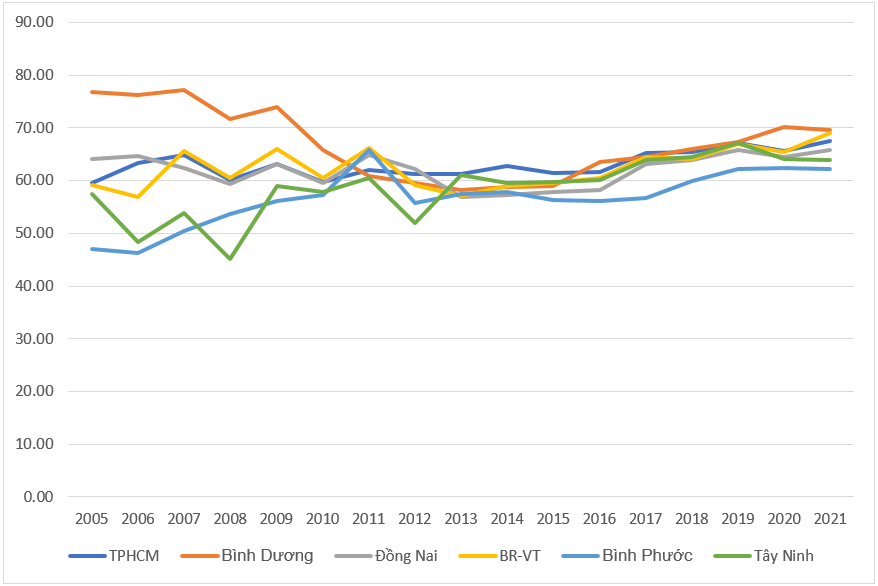
PCI score of each Province/City over the years. Source: PCI
The proportion of R&D/GRDP spending in the Region increased; actually, at a very low level. Consequently, the Region’s economy still points out the signs of slowing down in terms of growth because the Region, for many years, has been depending upon the capital-intensive, unskilled labor, and energy-intensive resource during economic development as well as the contribution towards TFP has decreased over time. The ratio of R&D/GRDP over the past 20 years for the whole Region, the current target is approximately 0.1%, which is a low rate for the Region because the economic structure favoring industry and necessary services must comprise high-proportion R&D so as to drive innovation and digital transformation for growth boost. If compared to R&D/GDP expenditure, the reference rate should be approximately 1%, which is the ideal ratio of countries in the region, listed as Thailand 1%, China higher than 2% of GDP. Ho Chi Minh City, individually, tends to improve positively, focusing on R&D investment from the low level since 2000 until the present time: the rate has doubled that of the regional average as approximately over 0.2% in 2021. Nevertheless, in order to keep the leading role as a leader in innovation and towards a technology-based growth model, combined with the model of Thu Duc City as an innovative and interactive city, the R&D rate of HCMC is being rather modest. In general, other localities have kept their R&D investment, at approximately less than 0.5% of GRDP.
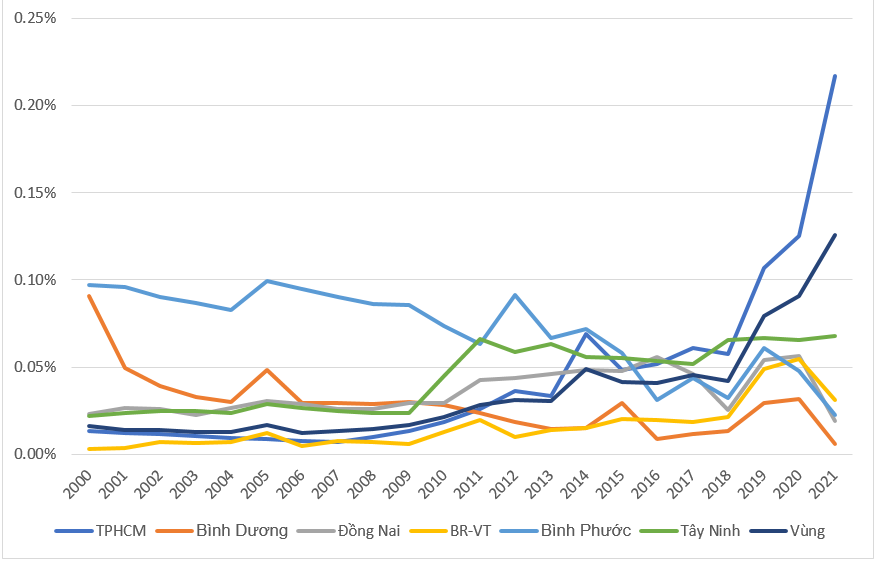
Ratio of R&D investment to GRDP. Source: Calculation from GSO data
The Region contributes to the general budget revenue of the country with a very high proportion; on the other hand, the average revenue and expenditure ratio of the region compared to that of the national budget expenditure has a large gap. Ho Chi Minh City plays an important role in the region’s overall budget revenue with an average rate of approximately 60% while those of other localities account for approximately 40%. The ratio of Regional budget revenue to National budget revenue is approximately 45-50%, very high compared to the ratio of regional budget expenditure to national budget expenditure of approximately 15%, especially in the period 2014-2020 when the ratio of regional budget revenue to national budget revenue indicated signs of decreasing and slowing down. This clarifies the important role of the Region in contributing to the national budget in the role of revenue collection and the leading role is by Ho Chi Minh City. Nevertheless, the budget expenditure for the Region has not been commensurate with the budget collection capacity of the Region in the context that the Region has other bottlenecks in connection with R&D and investment in terms of hard infrastructure with the purpose of creating more open and more efficient Regional connections, contributing to sustainable growth boost and continuing to contribute to the more sustainable national budget.
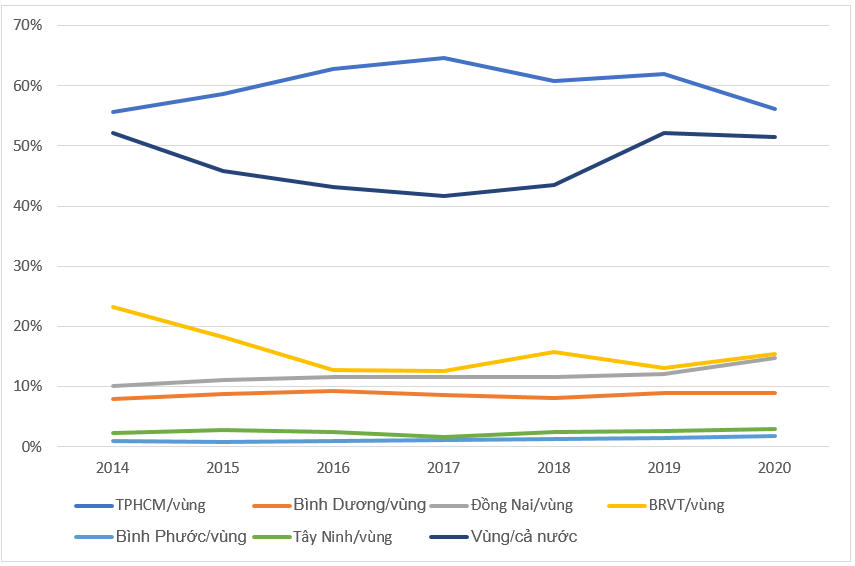
Budget revenue ratio. Source: Calculation from GSO data
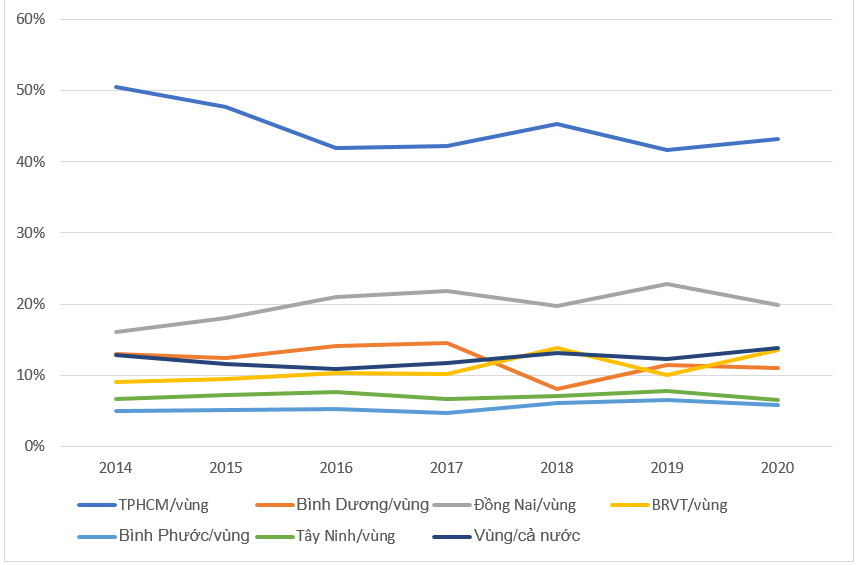
Budget expenditure ratio. Source: Calculation from GSO data
The bottleneck linking the Southeast region in production and consumption
The fundamental bottleneck is that the linkage at the SE region level for safe food supply and trade is facing the following difficulties: the legal mechanism for safe food linkage is not specifically designed because of the fact that administrative boundaries has been a factor dividing the food supply chain towards safe production and consumption. Moreover, the models of linking food production and consumption with food safety standards between megacities listed as Ho Chi Minh City (as a large consumption market for the population and for export) and other Provinces in the Region (as the location of raw material areas with large-scale production and processing) has been rather limited. Concurrently, the Regional linkage mechanism is not strong enough to solve the production and consumption linkages that can meet food safety standards between Ho Chi Minh City, major cities and agricultural production areas in the Region, resulting in the unsustainability in the supply chain and affecting the overall sustainable development of the Region.
The Southeast region has a population of more than 20 million people in various large cities, both producing and consuming a large amount of processed agricultural products and food; at the same time, serving export to the international market. Therefore, providing safe food for people in the whole region and especially in urban areas is very essential and given the top priority for commerce as well as for agriculture and rural development. Extending to all other non-agricultural economic sectors, the supply chain relationship of goods and services in the Provinces and Cities in the region is an important factor for economic development and social stability in the whole Region. In that case, Ho Chi Minh City, basically playing the role of the Regional logistics center, carries the role of manufacturing and supplying finished-products for domestic consumption and export together with other Provinces. In terms of the food and food industry, the intra-regional linkages among Provinces and Cities in the region on safe food production and consumption are essential to protect the health of tens of millions of residents and of the future generations of the Provinces/Cities in the region where HCMC is one megacity with more than half of the population in the region.
Water resource bottleneck in the Southeast Region
The allocation of economic activities and citizens’ livelihood is not optimal in compliance with the natural water resource allocation of the region and the cooperation - coordination mechanism among localities in the Southeast region in order to use the unclaimed water resources sustainably.
The Southeast Region has important economic, political and strategic significance in the Vietnam country. Effective and sustainable use and management of water resources in this region is particularly essential for Regional development, especially, the restructuring of the region towards sustainability in economical and efficient use of resources. What is more crucial, in terms of water resources, more and more problems related to the environment result from the fact that water resource management has not been effectively implemented in the direction of Regional governance. The management of water resources in the region must meet the needs of agricultural production, industry, hydroelectricity, daily life, aquaculture, tourism, entertainment, and environmental protection which are currently very high. However, the fact that the climate change alters the flow in the flood season and the dry season increases extreme weather events, the lack of water in the dry season, increasing the risk of flooding in big cities due to uncontrolled synchronization development of the drainage system. The deeper saltwater intrusion indicates that the Provinces in the Region, especially Ho Chi Minh City, will face a problem of water supply for production and daily life in the near future because they are located at downstream basin of Dong Nai River. The synergistic impact of climate change with the pressure of population growth and economic development creates great challenges for localities in the region in terms of water sources used for consumption and economic development.
If 100% of the flow in the basin is exploited, the basin can have enough or excess water if there are works to regulate, allocate and share water resources in the basin. Nevertheless, because natural water in the basin is unevenly distributed in space and time along with the impact of climate change, some localities in the region is in risk of water shortage; concurrently, economic activities, trade, and tourism services in the downstream areas face high risks of water quality degradation.
Ho Chi Minh City has the highest population size in the region as well as occupies a very high demand for natural water for tourism and commerce; the point is that HCMC is located at downstream basin of Dong Nai River. While some localities in the upstream region have a large proportion of industrial wastewater entering Dong Nai River basin, currently, only a few industrial parks have centralized wastewater treatment plants in operation. Industrial and handicraft production facilities of various sizes and industries are being operated; on the other hand, no data concerning waste sources is available.
Both Law on Water Resources No. 17/2012/QH13 and Law on Environmental Protection No. 72/2020/QH14 agree that the protection of river water environment and the management of water resources must be in compliance with one total management approach according to the basin features. However, the legal elements of the basin organization in terms of functions, responsibilities and powers have not been detailed and specified. The Environmental Protection Committee of Dong Nai River Basin (or Dong Nai River Commission) was established and assigned the basin management responsibility in accordance with Decree 120/2008/ND-CP. This responsibility is also assigned to the Ministry of Natural Resources and Environment, other Ministries and Ministerial-level agencies, Provincial People’s Committee (for intra-provincial river basins) and the National Council on Water Resources in Vietnam in accordance with Articles 33 to 38. This Committee (Environmental Protection Committee of Dong Nai River Basin) has the function of supervising and coordinating the activities of relevant ministries, branches and localities in the implementation of river basin planning; proposing policy promulgation; suggesting solutions on water environment protection, exploitation, use and development of water resources, prevention, control and mitigation of harms caused by water in river basins (extracted from Article 30, Decree 120/2008/ND-CP).
On the contrary, according to these reports, the organization and the operation mechanism of organizations related to river basin management have not yet undergone profound changes that allow this Commission to have a mechanism for implementing cooperation and coordination among localities in the Southeast Region. This form of organization is different from the way that other water resources are managed in the world.
Author: Prof. Dr. Nguyen Trong Hoai - Editor-in-chief of Journal of Asian Business and Economic Studies (JABES), University of Economics Ho Chi Minh City.
This is an article in the series of articles spreading research and applied knowledge from UEH with “Research Contribution For All - Nghiên Cứu Vì Cộng Đồng” message, UEH cordially invites Dear readers to look forward to the Knowledge Newsletter DIGITAL ECONOMY #70 [Podcast] Sustainable Restructuring of the Southeast Economic Region (Part 2): Regional Restrictions.
News, photos: Author, UEH Department of Marketing and Communication
Voice of: Ngọc Quí


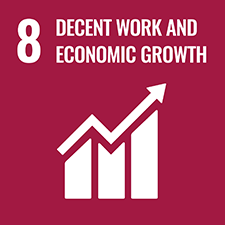
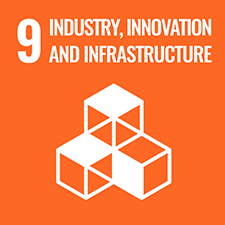
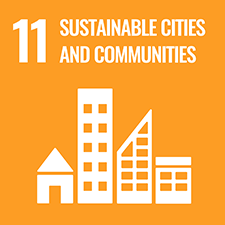
![[Research Contribution] Climate Adaptation and Ownership Structure: Determinants of Global Bank Performance](/images/upload/thumbnail/ueh-thumbnail-639024479352054880.png)

![[Research Contribution] Wage or Survival Fee? A New Perspective on Provincial Minimum Living Wages in Vietnam](/images/upload/thumbnail/ueh-thumbnail-639024468410266657.png)
![[Research Contribution] A Model for Assessing the Impact of Accounting Data Analytics on Sustainable Information Presentation in the Public Sector](/images/upload/thumbnail/ueh-thumbnail-639024469396621767.png)
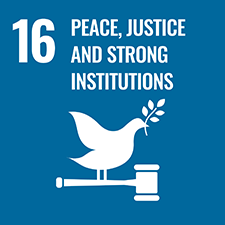

![[Research Contribution] A Strategy for Engaging Stakeholders to Implement Living Labs for Addressing Urban Issues](/images/upload/thumbnail/ueh-thumbnail-639024459455096821.png)
![[Research Contribution] Foreign preference and students’ intention to buy chinese fashion in Ho Chi Minh City](/images/upload/thumbnail/ueh-thumbnail-639024247663259881.png)
